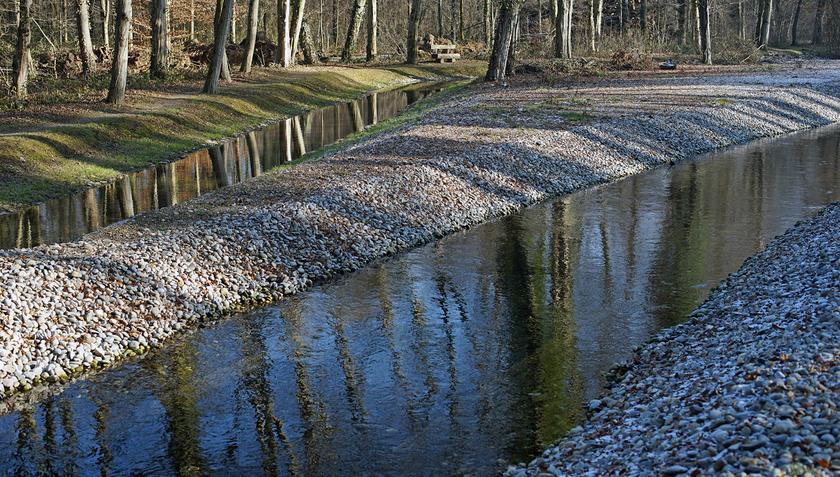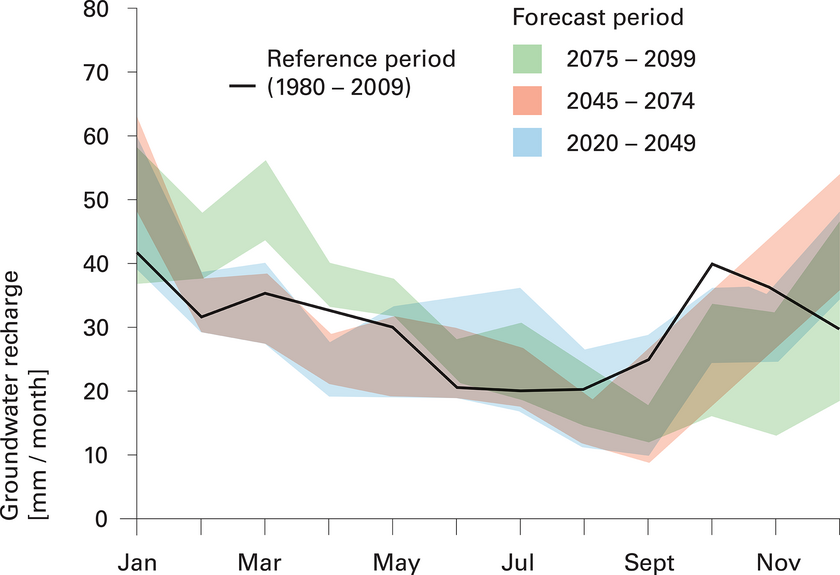Less water in summer, more in winter

Climate change is altering air temperature and precipitation patterns in Switzerland, thereby impairing the recharge and quality of groundwater. A mix of measures is needed to ensure the sustainable use of groundwater as a resource. Good forecasts enable timely action and support investment decisions.
The last three years were the warmest on record in Switzerland, with a deviation of 3.3 to 3.6 degrees from the pre-industrial average from 1871 to 1900. However, climate change is not only causing temperatures to rise, it is also changing precipitation patterns. “Over the course of a year, the amount of water remains roughly the same, but we have more water in winter and less in summer than before,” says Christian Moeck from Eawag’s Water Resources and Drinking Water department. “This has consequences for groundwater recharge, which is the process by which precipitation water seeps into the soil, reaches the groundwater and replenishes the aquifers.”
Due to climate change, it is highly likely that there will be longer dry periods in summer and autumn in future, during which there will be little or no groundwater recharge; in winter, on the other hand, there will be more recharge. Measurements at various locations and model calculations confirm this trend. “Although a basic quantification is possible, generally applicable figures for the whole of Switzerland can only be derived to a limited extent due to the great importance of local circumstances and the pronounced heterogeneity,” says Moeck. Climate change not only has a direct impact, there are also many cascade effects. If, for example, the groundwater level drops during a drought, the surface is also dry and more irrigation is required, causing the groundwater level to drop further. “This land use effect can have a greater influence than the actual precipitation deficit,” explains Moeck.
Heavy rain puts water quality at risk
However, climate change is not only altering temperature, precipitation and evaporation, heavy precipitation events also occur more often. Researchers are currently investigating in various studies whether this results in more groundwater being recharged than before. “But it is difficult to quantify the effect and there are still unanswered questions,” notes Moeck. It is important to consider not only the quantity but also the quality of the groundwater during extreme weather events. Pollutants can accumulate in the soil in dry conditions. During heavy rainfall or flooding, these are pushed through to the groundwater relatively quickly. As a result, the concentration of pollutants can increase after dry periods and subsequent heavy precipitation, also because there is less reaction time to break down the pollutants.
“You can’t look at the groundwater problem in isolation,” says Moeck. Various other components such as surface waters, soils, land use and ecosystems are connected to it. If the groundwater level lowers by a few centimetres, this may not be a problem for the water supplier, but it may harm the ecosystem. Compared with countries such as Spain or Portugal, however, Switzerland is in a good position. “In terms of volume, Switzerland will continue to act as a water tower for the most part, even in the wake of climate change – but there could be significant changes from a regional and seasonal perspective,” summarises Moeck. “We have to try not to simply let the extra water flow away in winter, but to retain it so that it can be used in summer when there is a deficit.”

Forecasts help water suppliers and decision-makers
Strategies must be developed and measures taken to achieve this. Short and long-term forecasts play an important role here. Moeck and his colleagues have developed models with which they can predict the groundwater dynamics for several weeks ahead. These models use forecasts of possible temperatures and precipitation events as a basis. The models calculate whether the groundwater level will rise or fall in the coming weeks. Tests have shown that the forecast system works. It could be integrated into a federal early warning system that already forecasts the development of water levels in surface waters as well as soil moisture.
“Our short-term forecasts can help water suppliers, for example, to better organise the pumping regime,” explains Moeck. If flooding is forecast, it is advisable to fill the water reservoirs in advance and to stop pumping during the flood situation to prevent contamination. If water shortages are expected, suppliers can appeal to the population to save water at an early stage. If neighbouring water supplies are networked, they can also help each other out in the event of a local drought (see article “We must preserve our drinking water resources” and “We want to give groundwater a face”). Several working groups from different institutes are currently working on improving and expanding such forecasts. The common goal is to provide decision-makers with reliable information so that they can react to changes at an early stage.
By contrast, the researchers want to use long-term forecasts to show how frequently dry periods, for example, occur and what consequences can be expected. These forecasts should lead to a better understanding of the fundamentals and thus provide a more sound basis for investment decisions, among other things. There are various ways in which water can be retained and the groundwater artificially recharged. Obvious measures include retention basins that collect and store excess rainwater and release it again after a certain time. Slow water projects aim to slow down surface runoff – for example by creating infiltration trenches, planted depressions or small ponds. Woody plants can also help to reduce surface runoff. In addition, approaches such as managed aquifer recharge (MAR) offer interesting possibilities. Here, water is channelled into the subsoil in a targeted manner, for example via infiltration channels or seepage areas, in order to raise the groundwater level locally and store water for dry periods. Such measures are currently being tested and further developed in various research institutions and practical projects, in both urban and rural areas.
“The question remains as to whether these investments are not only beneficial locally, but also on a larger scale,” says Moeck: “A structural measure alone will probably not be enough. Ultimately, a mix of different measures will be required for the sustainable use of groundwater as an important resource.”
Created by Barbara Vonarburg for the Info Day Magazine 2025
Links
Artificial groundwater recharge: example in the Muttenzer Hard
Slow Water Project: Slowing down, infiltrating and storing rainwater on farms and in water catchment areas


